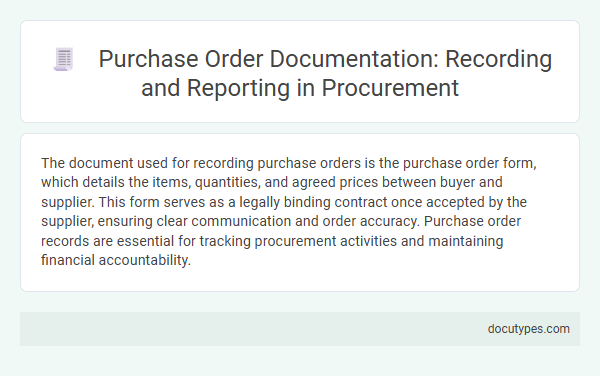The document used for recording purchase orders is the purchase order form, which details the items, quantities, and agreed prices between buyer and supplier. This form serves as a legally binding contract once accepted by the supplier, ensuring clear communication and order accuracy. Purchase order records are essential for tracking procurement activities and maintaining financial accountability.
Introduction to Purchase Order Documentation
Purchase order documentation is essential for managing procurement processes in businesses. It serves as a formal record that details the products or services a buyer intends to purchase from a supplier. Accurate documentation helps ensure clarity, accountability, and smooth transaction workflows between purchasing and finance departments.
Importance of Accurate Purchase Order Records
The document used for recording purchase orders is the Purchase Order (PO) form, which serves as the official record of goods or services requested by a buyer. Accurate purchase order records are crucial for maintaining clear communication between buyers and suppliers, ensuring order fulfillment, and facilitating financial audits. You can prevent errors and discrepancies by maintaining detailed and precise purchase order documentation, supporting effective inventory management and budget control.
Key Components of a Purchase Order
Purchase orders are the official documents used to record and authorize purchases between buyers and suppliers. They ensure clarity and legal protection by detailing the specifics of the transaction.
- Order Number - A unique identifier that tracks the purchase order for reference and auditing purposes.
- Item Description - Detailed information about the products or services being ordered, including specifications and quantities.
- Terms and Conditions - The agreed-upon rules regarding payment, delivery schedules, and other contractual obligations.
Standard Procedures for Documenting Purchase Orders
Purchase orders are typically recorded using a standardized Purchase Order (PO) form or electronic PO system. These documents ensure clear communication between buyers and suppliers, specifying the details of the purchase.
Standard procedures for documenting purchase orders include creating a unique PO number, listing item descriptions, quantities, and agreed prices. Maintaining a record of the PO helps streamline order tracking and auditing processes. Your organization can improve accuracy and accountability by consistently following these documentation practices.
Digital vs. Manual Purchase Order Systems
Purchase orders are recorded using either digital purchase order systems or manual purchase order forms. Digital systems utilize software platforms to capture, track, and store purchase order data electronically.
Manual purchase order systems involve handwritten or printed forms that are physically filed and managed. The choice between digital and manual methods impacts efficiency, accuracy, and ease of access to purchase order records.
Steps for Effective Purchase Order Reporting
The document used for recording purchase orders is typically a Purchase Order Form or Purchase Order Report, which ensures accurate tracking of procurement activities. Effective reporting enhances transparency and streamlines order management.
- Identify the Purchase Order Document - Use a standardized Purchase Order Form or digital Purchase Order Report to capture all relevant order details consistently.
- Record Accurate Information - Ensure all fields such as vendor name, order date, item descriptions, quantities, and prices are correctly entered for precise documentation.
- Regularly Review and Update - Maintain timely updates on purchase order statuses and review records to detect any discrepancies or missing data promptly.
Compliance and Audit Requirements in Procurement
Purchase orders are formally recorded using purchase order documents that capture essential transaction details. These documents ensure compliance with procurement policies and facilitate audit trails during reviews.
- Purchase Order Form - A standardized document used to detail the items, quantities, and agreed prices for purchases.
- Compliance Records - Purchase order documentation must adhere to regulatory standards and internal control policies to ensure transparency.
- Audit Trail - Properly maintained purchase orders provide verifiable evidence for auditors to assess procurement accuracy and authorization.
Documenting purchase orders thoroughly supports regulatory compliance and strengthens audit readiness in procurement processes.
Common Challenges in Purchase Order Documentation
| Document Used for Recording Purchase Orders | Purchase Order Form (PO Form) |
|---|---|
| Purpose | Official record of goods or services requested from suppliers |
| Key Components | Purchase order number, supplier details, item descriptions, quantities, prices, delivery dates, payment terms |
| Common Challenges in Purchase Order Documentation |
|
Best Practices for Record Maintenance
Which document is used for recording purchase orders? Purchase orders are typically recorded using a Purchase Order Form, an official document that outlines the details of the transaction between buyer and supplier. Maintaining accurate and organized purchase order records helps ensure compliance and streamline audit processes for your business.
Which Document Is Used for Recording Purchase Orders? Infographic

